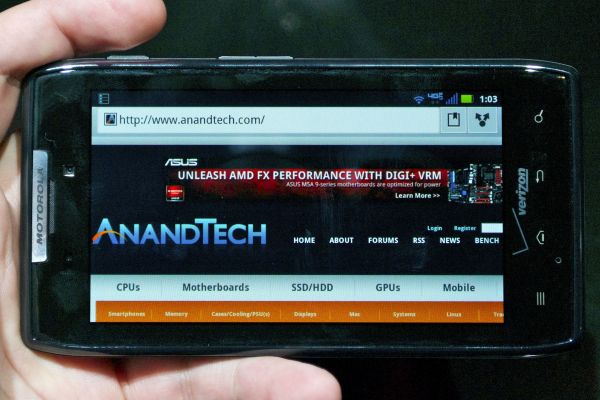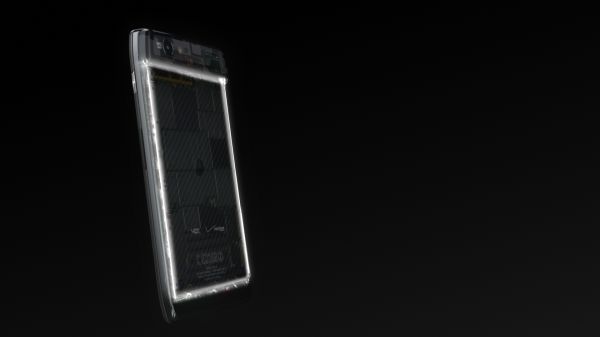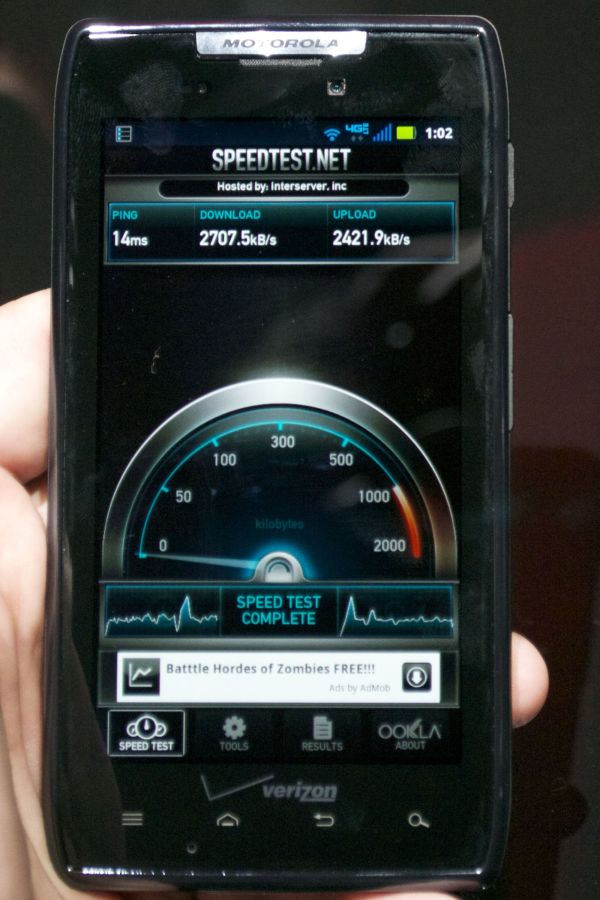Hands-on With The Motorola Droid RAZR
by Jason Inofuentes on October 18, 2011 3:14 PM EST- Posted in
- Motorola
- OMAP
- Verizon
- Smartphones
- Mobile
- Droid RAZR
- AMOLED
Unlike some prior events, reps were more than happy to let us get our grubby mits on the devices. Even going so far as to let us run benchmarks, as you can see, something often left until the PR reps are not looking. In fact, I was surprised when Motorola Product Manager Jeff Snow actually volunteered the SunSpider scores as soon as he saw our tag. This sort of access was appreciated and adds a lot to our coverage in the lead up to a full review. We got plenty of time with the Droid RAZR and got great answers from Jeff and his team. So what does the "world's thinnest smartphone" feel like?
Hardware wise, this feels as light as the SGSII (and it should at 127g it is 3g lighter than the Samsung Epic 4G Touch), but with a rigidity in the hand that you don't get from Samsung's thinnest phones. The stainless steel chassis of the device provides this rigidity, while being exceptionally thin, other body components are laminated upon this chassis to keep the phone thin, including the Kevlar layer that graces the back of the phone. It's unclear whether this is anything but a cosmetic addition, but either way it looks great. The Gorilla Glass covered display tapers down into the frame, like the Bionic, and at the similarly tapered corners of the device. Motorola's design language is much curvier than the original Droid. We've got a comparison table below that gives you dimensions, it feels similar to other 4.3" devices in the hand, despite being a little wider and a little taller, but compared to the Bionic the thinness is very noticeable. And the 30g weight savings is easy to notice. Update: Added Galaxy Nexus and Galaxy S II to the table.
| Physical Comparison | ||||||
| Galaxy Nexus | Galaxy S II (International) | Motorola Droid RAZR | Motorola Droid Bionic | |||
| Height | 135.5 mm (5.33") | 125.3 mm (4.93") | 130.70 mm (5.15") | 127.5 mm (5.02") | ||
| Width | 67.94 mm (2.67") | 66.1 mm (2.60") | 68.90 mm (2.71") | 66.9 mm (2.63") | ||
| Depth | 8.94 mm (0.35") | 8.49 mm (0.33") | 7.1 - ?? mm (0.28" - ??") | 10.99 mm (0.43") | ||
| Weight | 135 g (4.76 oz) | 115 g (4.06 oz) | 127 g (4.48 oz) | 158 g (5.57 oz) | ||
| CPU | 1.2 GHz Dual Core Cortex-A9 OMAP 4460 | 1.2 GHz Dual Core Exynos 4210 | 1.2 GHz Dual Core Cortex-A9 OMAP 4430 | 1 GHz Dual Core Cortex-A9 OMAP 4430 | ||
| GPU | PowerVR SGX 540 (@384 MHz) | ARM Mali-400 | PowerVR SGX 540 (@304 MHz) | PowerVR SGX 540 (@304 MHz) | ||
| RAM | 1 GB LPDDR2 | 1 GB LPDDR2 | 1 GB LPDDR2 | 1 GB LPDDR2 | ||
| NAND | 16 / 32 GB NAND | 16 GB NAND with up to 32 GB micro SD | 16 GB NAND, 16 GB microSD class 4 preinstalled | 16 GB NAND, 16 GB microSD class 4 preinstalled | ||
| Camera | 5 MP with autofocus and LED flash, 1080p30 video recording, 1.3 MP front facing | 8 MP with AF/LED Flash, 2MP front facing | 8 MP with AF/LED Flash, 1080p30 video recording, 720p front facing | 8 MP with AF/LED Flash, 1080p30 video recording, VGA front facing | ||
| Screen | 4.65” 1280 x 720 Super AMOLED | 4.27" 800 x 480 Super AMOLED Plus | 4.3" 960 x 540 Super AMOLED Advanced | 4.3" 960 x 540 RGBW LCD | ||
| Battery | ?Removable 6.48 Whr | Removable 6.11 Whr | Sealed 6.56 Whr | Removable 6.11 Whr | ||
Whipping around the UI was a breeze, transitions were snappy and opening and closing the app drawer was smooth. Opening apps was quick and as Anand mentioned in our browser preview, this is not the browser we handled in the Bionic. We don't know where the optimizations came from but scrolling and zooming were quick. Connected to Verizon's 4G LTE network we got decent, though not spectacular Speedtest scores inside the event venue. Loading the Anandtech homepage was quick, and the only one pause that I noted was likely the Flash components loading.
The display was bright and crisp, and if it didn't come off in the pictures, let me be sure to mention that the viewing angles were spectacular. At this point, we've come to expect good things from Super AMOLED displays, and this looked good. The question is, what type of pixel arrangement are we looking at? We confirmed with Motorola that the display was Pentile, and initially it was described as the same arrangement as in the Bionic, which would make it RGBW. We haven't seen an AMOLED RGBW display yet so this was surprising. Further clarification leaves us still a bit confused, as it is now being described to us as RGB Pentile. This is likely RGBG Super AMOLED, though we won't know for sure till it comes in as this will be the first qHD Super AMOLED display we've seen, whichever Pentile stripe it comes in.
We'll know more when the review sample comes in but for now we can say that this phone felt every bit as fast as the Samsung Galaxy S II, had an impressive display and felt great in the hand. Stay tuned for our review as soon as we can get it out, and stay tuned for more coverage tonight.














14 Comments
View All Comments
piroroadkill - Wednesday, October 19, 2011 - link
At least, at 1800mAh, it's a healthy capacity..Omid.M - Wednesday, October 19, 2011 - link
Anyone else find the phone painfully unremarkable? The corner, the metal strip in the center....it's so bland. Design hasn't really been Moto's strength. Should've contracted a Frog Design or something up here in SF (Yves Behar, where you at?).I tweeted re: the locked bootloader and Moto replied that they do it for "security" reasons and based on carrier requirements. I replied back that HTC has been unlocking its phones, so that excuse is invalid.
@moids
JasonInofuentes - Wednesday, October 19, 2011 - link
Maybe I'm alone, or maybe my pictures don't do it justice, I found the phone quite striking actually. In images the tapered corners do look a bit awkward but in person it really holds together well. I actually prefer this to the T-mo and Sprint SGSII variants.As for bootloaders, we can't truly expect absolute access on all of these devices. It's just unrealistic. A lot of consideration goes into the software on a mobile phone. While one technical rep was showing off the software on the device, I asked whether certain things would be deletable, the PR minder standing next to him chimed in that the software package is included to enhance the users experience and they expect users to be satisfied with it as is. This was typical PR nonsense. The tech rep saved the moment though by pointing out that some of the software is contractual and does show big benefits from being included, such as the NFL app (Moto and VZW are NFL sponsors) which looks great on the screen and streams great thanks to LTE. The games they chose (I forget them right now) were chosen to highlight the graphics prowess (hopefully that means Let's Golf is gone).
My point, then, is that just because the technical staff wants us to be able to unlock the bootloader and have our way with the device, doesn't mean that there aren't a million factors that make this impossible. Verizon's influence alone could be enough to stymie this initiative. And if Motorola dragging its feet spares us the ugly compromise HTC chose to implement its unlocking scheme, then I'm all for it.
sammsiam - Friday, October 21, 2011 - link
There seems to be a lot of misinformation about HTC unlocking boot-loaders. What HTC (& Motorola, for that matter) said was they would unlock models that the carriers allowed them to. So far, HTC has unlocked only 1 model device for the US market (Sprint, specifically). See the list here: http://htcdev.com/bootloaderYou can pretty much bet that VZW won't allow unlocking. At least they have shown absolutely no indication they will start.